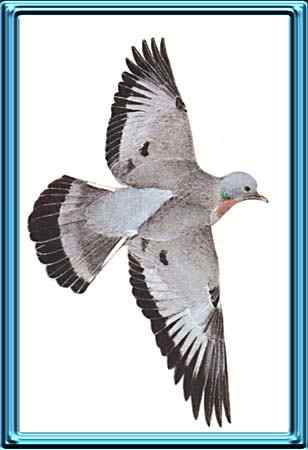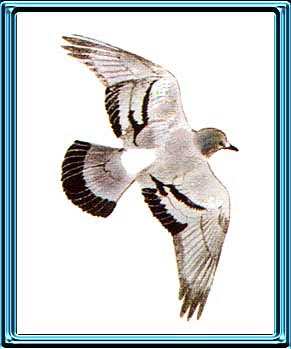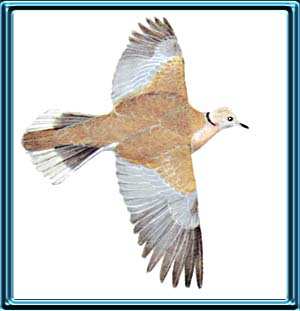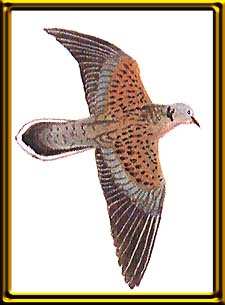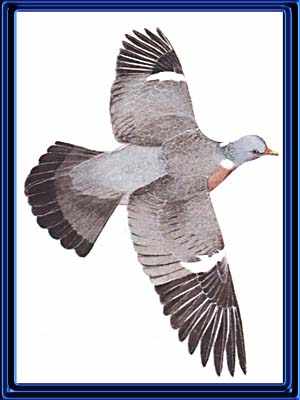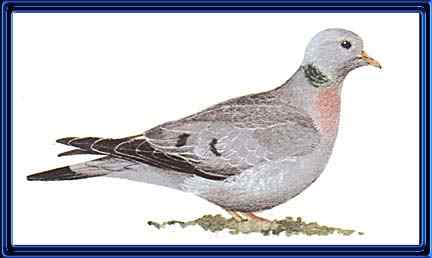
Columba
oenas
(The
Stock Dove)
The Stock Dove is resident in this country and may be distinguished from the Wood Pigeon by its much smaller size and the absence of white on the neck and wings. It is the same size as the Rock Dove (see below) but without the pale rump and bold wing bars. The plumage is grey being paler beneath, it has a ruddy tinge on the breast and purple sheen on the neck. There are two short thin bars at the base of the wing, which also has a black upper wing border with the tail tip also black. The bill is yellowish going red at the base, and the feet are deep pink.
This type of dove is fairly common in many habitats and is only absent in the far north. This species is often overlooked with other pigeon types.
This species is less of a pest than say a wood pigeon because it feeds mainly on weed seeds.Biology:
Size: Averages a length of 13 inches or 33cm.
Habitat: Chiefly open countryside and cliffs
Nesting Site: Usually a hole in a tree, or rocks. Sometimes in a ruin or creeper or the old nest of another bird.
Eggs: Lays 2 per clutch which are creamy/white, between the months of March and October.
Food: Chiefly weed seeds and young shoots, also grain, mast, acorns, snails etc.
Hatch Time: About 17 days.
The picture below shows the Stock Dove in flight, note the black wing edges with no white above and that the wing bars are very small.
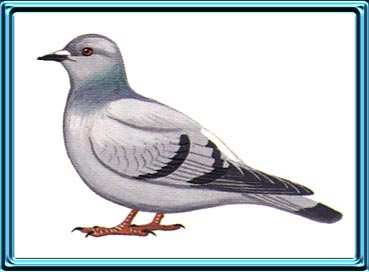
Columba
livia
(The Rock Dove/Feral Pigeon)
(The Rock Dove/Feral Pigeon)
Rock Doves were kept for food in the Middle Ages and are resident in this country, but many escaped from the dovecotes and their descendants are the feral pigeons seen in city squares, streets and railway stations. The feral pigeons can still interbreed with the Rock Doves. The Rock Dove is the wild forebear of the modern "Domestic" and "Homing" pigeons, this includes the chequers, fantails, black and whites, tumblers and racers.The true Rock Dove is now found only on the rocky cliffs of north and west Scotland and Ireland. Doves seen on inland cliffs and in caves are domestic pigeons which have become wild (feral). It makes an untidy nest on a cliff or in a cave and lays eggs at intervals throughout the year. The Rock Dove's major enemy is the peregrine falcon, which is now quite rare. The plumage is grey with a green and purple sheen on the neck with also a whitish rump and lower back. There are two black bars which cross the secondaries and the feet are red.
Biology:
Size: The same as the Stock Dove i.e.. 13 inches or 33cm.
Habitat: Coastal.
Nesting Site: Usually made of seaweed or twigs and grass on a ledge, in a crevice in the rocks or in a cave.
Eggs: Lays two eggs/clutch which are white, during the period March-September.
Food: Feeds mainly on seeds, grain, seaweed and shellfish.
Hatch Time: About 18 days.
Note the white rump and the bars on the inner wing
the feral pigeon is often identical.
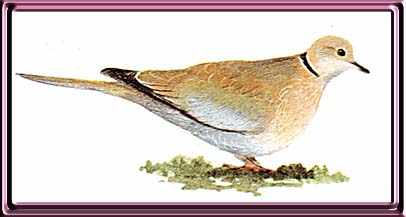
Streptopelia decaocto
(Collared Dove)
The Collared Dove was unknown Britain until 1952, and in 1955 a pair from the Continent nested in Norfolk. Now it breeds throughout Britain and in most of Ireland.It is a medium to small sandy coloured pigeon with the head, neck , breast and belly a more paler pinkish-buff. The collar band is a continuous black and white crescent distinctive in the adult but lacking in the immature bird. In flight wings show dark tips and conspicuous blue-grey forewing patches, the brown tail with the broad, white terminal band is striking (see the picture below).
Biology:
Size: About 11 inches long (28cm).
Habitat: Inhabits farmland, parks, urban areas, is widespread and common.
Nesting: Collared doves build flat nests in trees or on building ledges.
Eggs: These are white and laid 2/clutch during the months of March-September.
Food: Chiefly grain, in fields and hen runs, but also eats weed-seeds and berries.
Hatch Time: Usually 14 days.
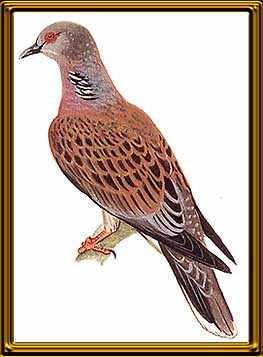
Streptopelia
turtur
(The Turtle Dove)
(The Turtle Dove)
The deep, purring "tur tur" of the Turtle Dove can be heard from April to September, when it visits Britain from tropical Africa. It is the smallest of Britain's pigeons and doves and breeds commonly in the south and Midlands, rarely in Scotland and Ireland, where if found in the latter two it is only a passing migrant.The plumage is chestnut on the back with black markings (scallops); the underparts are pinkish, the head, flanks and rump are light grey, with a few black and white stripes on the sides of the neck. The black tail is wedge shaped with a bold white border to the tip which is conspicuous in flight, the legs are red.
Biology:
Size: About 10.5 - 11 inches long (27cm).
Habitat: Fairly common in the south and east, associated with trees and cultivated land, but also parks and gardens.
Nesting: Builds a flimsy nest made of twigs high in a tree.
Eggs: Lays 2 white eggs/clutch between the months of May-July.
Food: Feeds on the seeds of weeds such as Common Fumitory, Chickweed, Charlock and Grass
Hatch Time: Usually about 14 days.
If looked at from underneath the white belly and black tail markings are obvious
from the top the chestnut wing-coverts and tail pattern.
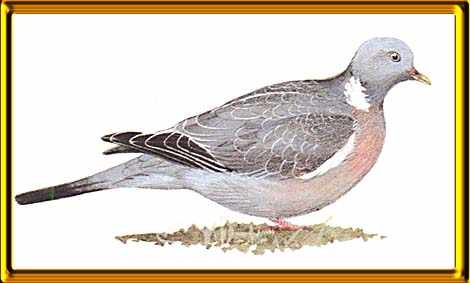
Columba
polumbas
(Ring Dove or Wood Pigeon)
(Ring Dove or Wood Pigeon)
The Wood Pigeon is the largest species in Britain, and is the bane of a farmers life. Year round shooting has failed to reduce it's numbers in fact it is thought that the autumn cull serves to enable the wood pigeon to survive through the winter because of limited food supplies, and in so doing help keep the numbers up.The soft coo of the wood pigeon has a soothing sleepy sound on spring and summer days. The general colour of the plumage is grey , lighter beneath and nearly black at the tail. There is a dusky reddish tinge on the breast, and a purple and green sheen to the neck. The main distinguishing marks are the white mark on the neck and the large white bar on the wings, which are very noticeable in flight, (see the picture below).
Biology:
Size: The largest of all the doves at 16 inches (41cm).
Habitat: Woods and forests but has adapted to town parks and gardens.
Nesting: The nest is rather flat and is usually sited in trees or shrubs/bushes.
Eggs: Lays two white eggs/clutch between the months of April-August. Sometimes earlier or later.
Food: Newly sown grain, weed seeds, acorns, nuts, berries, caterpillars, slugs etc.
Hatch Time: Usually 17 days, when the hatchlings are fed by both parents with "milk". Pigeons are the only birds to produce a milk similar to that of mammals. It is rich in protein and appears as a cheesy substance in the birds crop.
